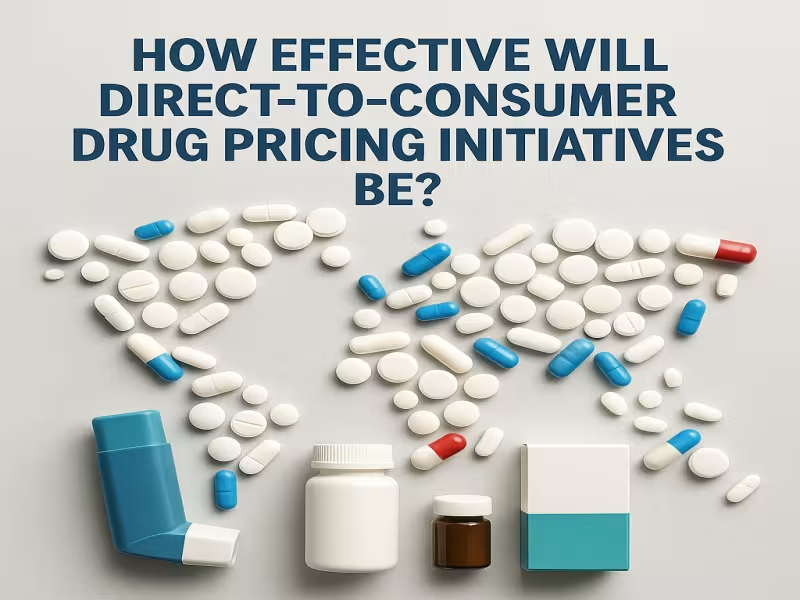
SHERIDAN, WYOMING - November 13, 2025 - As the TrumpRx platform approaches launch in early 2026, U.S. drugmakers are rolling out targeted direct-to-consumer pricing for a carefully chosen mix of dermatology, respiratory, cardiovascular, immunology, and metabolic products. While the discounts generate attention, analysts say their commercial impact varies sharply by drug class, revenue cycle, and therapeutic demand-revealing a strategic pattern rather than a broad affordability shift.
Discounting Patterns Reveal Manufacturers' Portfolio Priorities
Pfizer, AstraZeneca, Amgen, Bristol Myers Squibb, Novo Nordisk, and Lilly have each chosen different subsets of products for deep DTC price cuts. Across these offerings, a clear pattern emerges: brands with declining growth, approaching patent expirations, or limited payer friction are overrepresented.
Pfizer's discounted trio underscores the strategy. Eucrisa and Zavzpret represent smaller revenue contributors in dermatology and migraine, while Xeljanz-once a blockbuster-now faces steep sales erosion and looming U.S. patent loss. By offering Xeljanz at a 40% discount through TrumpRx, Pfizer reshapes the narrative without compromising insurer-negotiated net pricing.
AstraZeneca's portfolio reveals similar logic: discounting Bevespi, Breztri, and Airsupra allows the company to participate publicly in federal pricing initiatives without touching its highest-value categories such as oncology or biologics. These inhaler products occupy competitive primary care segments where DTC pricing has low payer downside.
GLP-1 Therapies Stand Out as the Only Segment With Real Market Sensitivity
In contrast to legacy brands, GLP-1s represent the first major therapeutic area where DTC pricing could shift patient behavior at scale. Wegovy and Zepbound sit at the center of a high-demand, supply-constrained market with cash-pay costs that routinely exceed $1,300 per month-even for insured patients.
That makes Novo Nordisk's and Lilly's MFN-linked discount agreements meaningful. Reducing monthly GLP-1 costs to around $350 could influence adherence, expand access to Medicaid and Medicare populations, and ease pressure on employers facing unprecedented utilization spikes.
As pharmacist Tyler Young noted, the GLP-1 sector represents a unique environment: cash markets are "significantly higher" and many patients struggle with restrictive coverage rules. The combination of high demand, high list prices, and inconsistent insurance coverage makes weight-loss drugs the outlier where DTC could materially influence market share.
Cardiometabolic Therapies Show Divergent Value for DTC Expansion
Amgen's approach to Repatha highlights the complexities in cardiometabolic markets. Offering the PCSK9 inhibitor at $239 through AmgenNow appears aggressive, but the move sends mixed signals. While the discount is deep relative to list price, most Medicare and Medicaid patients already pay far less under existing benefits. For a therapy heavily dependent on physician-driven adoption, analysts remain skeptical that DTC pricing will meaningfully alter demand curves.
Still, Repatha sits at the high end of Amgen's growth drivers, supported by new primary-prevention data and expanding clinical indications. DTC pricing may have less to do with patient affordability and more to do with building brand favorability ahead of a broader commercial push.
Stakeholder Analysis: Many Discounts Target Low-Impact Patient Segments
Experts emphasize that DTC discount strategies often focus on drugs where insurers already negotiate low out-of-pocket costs. As Vance Ginn explained: "Even the best market-based DTC/generic solutions won't address the much larger part of the market that's made up of life-saving specialty drugs."
This dynamic is evident across dermatology and respiratory drugs, where list prices appear high but insured patient copays are minimal-making DTC a symbolic gesture rather than an economic one.
Competitive Outlook: Limited Disruption Expected Outside High-Demand Categories
For most therapeutic classes, TrumpRx and parallel DTC programs are unlikely to upend payer structures or displace traditional pharmacy channels. Instead, they function as:
- Lifecycle management tools for aging brands
- Transitional strategies near patent cliffs
- Compliance with political pressure on affordability
- Low-risk experiments in consumer-facing commercialization
The notable exception is the GLP-1 category, where demand, pricing elasticity, and broad clinical use create conditions for measurable impact.
Learn More
For further market analysis and drug pricing developments, please visit https://www.fda.gov.